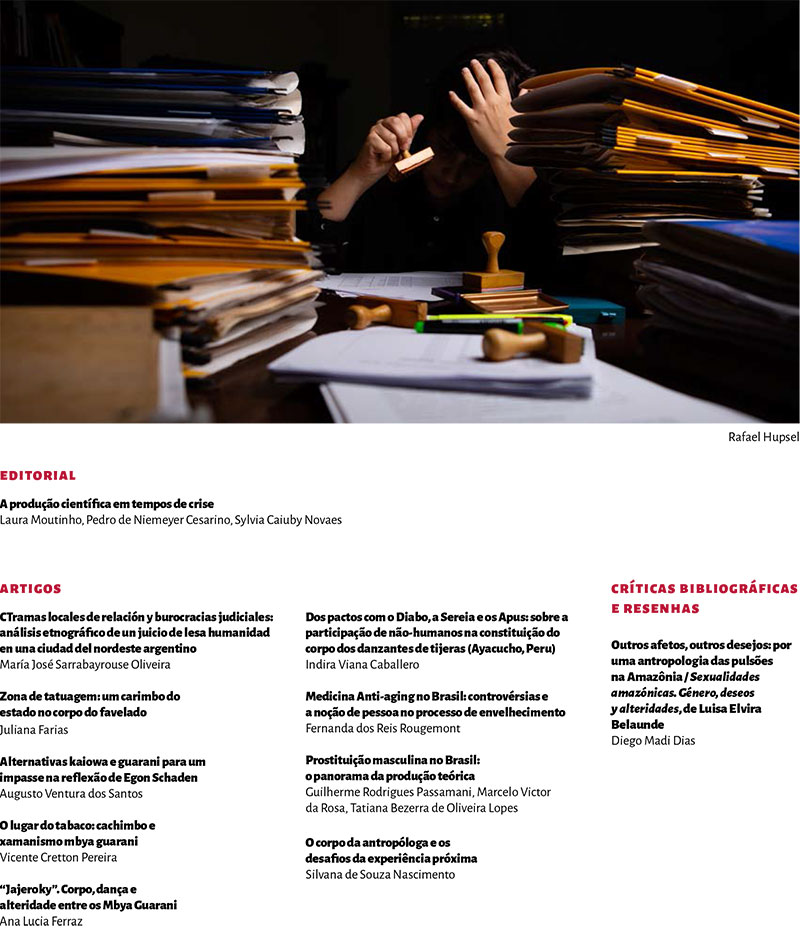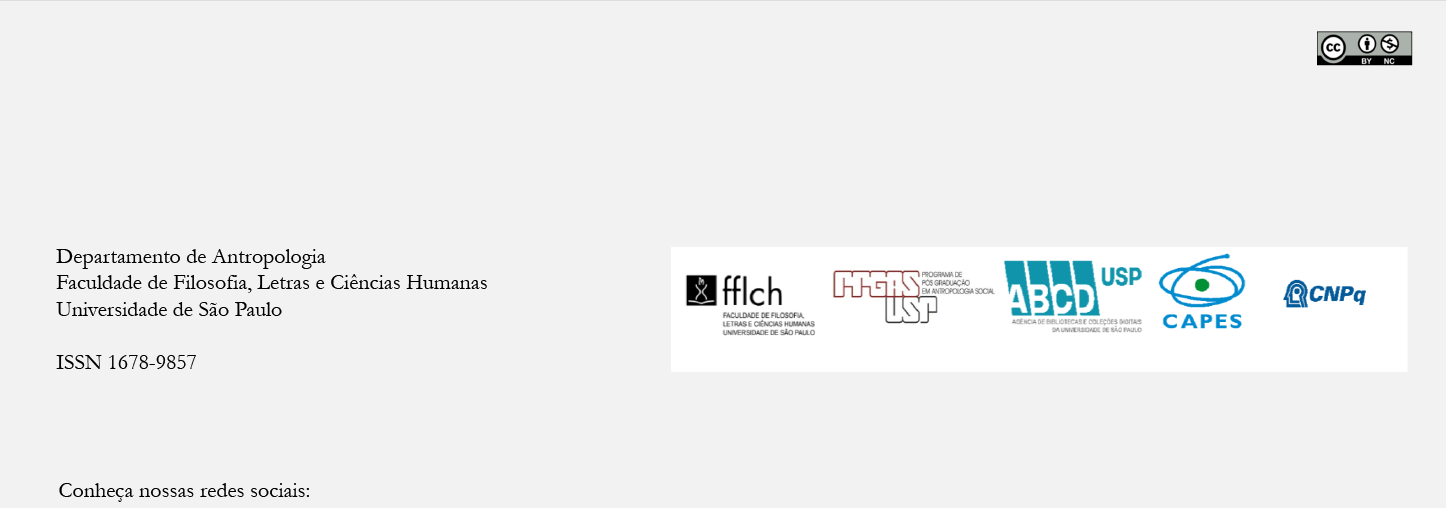Anti-Aging Medicine in Brazil: controversy and the Notion of Personhood in the Process of Aging
DOI:
https://doi.org/10.11606/2179-0892.ra.2019.161077Keywords:
Aging, Personhood, Body, Active Aging, Anti-Aging MedicineAbstract
This article is aimed to analyze the notion of the person in the aging process. Through the study about the controversies of the development to the Anti-aging Medicine in Brazil, the article explores the adjustment of the representation on aging process considering the transformations in the medical-scientific view and the emergent concept of the "active aging” as the paradigm. The analysis highlighted the divergent perspectives of the aging in the research with practitioners of Anti-aging Medicine and objector representatives of the Brazilian Federal Council of Medicine. The text presents the linkage between the physical-biological dimension of getting old and the moral constitution of personhood throughout the life cycle. It is emphasized the contrast between the modern Western personhood features and the expected physical decline of aging.
Downloads
References
ANTÓNIO, Manuel. 2015. Envelhecimento Ativo e o recurso à Medicina Tradicional Chinesa: entre a responsabilidade individual e os fatores sociais determinantes da saúde. Lisboa, Tese de doutorado, Universidade de Lisboa.
BOURDIEU, Pierre. 1983. “A juventude é apenas uma palavra”. In BOURDIEU, Questões de sociologia. Rio de Janeiro, Editora Marco Zero, pp. 154-161.
BOURDIEU, Pierre. 2006. A ilusão biográfica. In: AMADO, Janaina & FERREIRA, Marieta M. (orgs.). Usos e abusos da história oral. Rio de Janeiro: Fundação Getúlio Vargas, pp. 183-191.
CAMARANO, Ana Amélia. 2001. O idoso brasileiro no mercado de trabalho. In: Congresso Nacional de Estudios del Trabajo - ASET, 5., 2001, Buenos Aires. Anais (online). Buenos Aires, ASET. Disponível em: <https://www.aset.org.ar/congresos/5/aset/PDF/Camarano.PDF>. Acessado em 19 de maio de 2017.
CARADEC, Vincent. 2011. “Sexagenários e octogenários diante do envelhecimento do corpo”. In: GOLDENBERG, M. (Org.), Corpo, envelhecimento e felicidade. Rio de Janeiro, Civilização Brasileira, pp. 21-44.
CENTRO INTERNACIONAL DE LONGEVIDADE BRASIL. 2015. Envelhecimento ativo:um marco político em resposta à revolução da longevidade. Rio de Janeiro, Centro Internacional de Longevidade Brasil.
CONSELHO FEDERAL DE MEDICINA. 2012a. Modulação hormonal bioidêntica e fisiologia do envelhecimento.Parecer-consulta. Relator: Conselheiro Gerson Zafalon Martins. Nº 29/12, 13 de julho de 2012.Disponível em: < http://www.portalmedico.org.br/pareceres/
CONSELHO FEDERAL DE MEDICINA. CFM/2012/29_2012.pdf> . Acessado em: 28 de abril de 2017.2012b Resolução n° 1.999, 19 de outubro de 2012. Diário Oficial da República Federativa do Brasil, Brasília, 19 de outubro. Seção 1: 139. Disponível em: <http://www.portalmedico.org.br/resolucoes/CFM/2012/1999_2012.pdf.> Acessado em: 28 de abril de 2017.
DEBERT, Guita. 2004A. reinvenção da velhice:socialização e processos de reprivatização do envelhecimento. São Paulo, Editora da Universidade de São Paulo.
DEBERT, Guita. [1998] 2007 “A antropologia e os estudo dos grupos e das categorias de idade”. In: BARROS, M. L. (Org.), Velhice ou terceira idade?. Estudos antropológicos sobre identidade, memória e política, 4ª ed. Rio de Janeiro, Editora FGV, pp. 47-68.
DEBERT, Guita. 2011 “Velhice e tecnologias do rejuvenescimento”. In: GOLDENBERG, M. (Org.), Corpo, envelhecimento e felicidade. Rio de Janeiro, Civilização Brasileira.
DUARTE, Luiz Fernando Dias. 2003. “Indivíduo e pessoa na experiência da saúde e da doença”. Ciência & Saúde Coletiva, vol. 8, n. 1, pp. 173-183.
DUMONT, Louis. [1967] 1997. Homo Hierarchicus: o sistema de castas e suas implicações. São Paulo: EDUSP.
ELIAS, Norbert. 1998. Sobre o tempo. Rio de Janeiro: Jorge Zahar Editor.
GEMS, David. 2011. “Tragedy and delight: the ethics of decelerated ageing”. Phil. Trans. R. Soc. B, vol. 366, n. 1561, pp. 108-112.
GOLDMAN, Marcio. 1996. “Uma categoria do pensamento antropológico: a noção de pessoa”. Revista de Antropologia, pp. 83-109.
HORIBE, Edith; HORIBE, Kose. 2010. A juventude além do tempo: os 6 pilares da saúde para deixar você mais jovem por mais tempo. São Paulo: Gente.
IBGE. 2015. Síntese de Indicadores Sociais - Uma Análise das Condições de Vida da População Brasileira. Rio de Janeiro, IBGE. Disponível em: <http://biblioteca.ibge.gov.br/visualizacao/livros/liv95011.pdf > Acessado em 15 de março de 2017.
INGOLD, Tim. 1999. “Three in one: on dissolving the distinctions between body, mind and culture”. The Laboratory of Comparative Human Cognition. San Diego. XMCA Research Paper Archive. Disponível em: <http://lchc.ucsd.edu/mca/Paper/ingold/ingold2.htm>. Acessado em: 10 de julho de 2018.
INGOLD, Tim. 2000. The Perception of the Environment: Essays on Livelihood, Dwelling and Skill. London, Routledge.
INGOLD, Tim; HALLAM, Elizabeth2007 “An introduction”. In INGOLD, T; HALLAM, E. (Orgs.), Creativity and cultural improvisation. Oxford, Berg, pp. 1-24.
IPEA. 2015. Boletim Mercado de Trabalho - Conjuntura e Análise nº 59. Disponível em: <http://www.ipea.gov.br/portal/images/stories/PDFs/mercadodetrabalho/bmt_59_completo.pdf > Acessado em 10 de abril e 2017.
KAMPF, Antje; BOTELHO, Lynn. 2009. “Anti-Aging and Biomedicine: Critical Studies on the Pursuit of Maintaining, Revitalizing and Enhancing Aging Bodies”. Medicine Studies, n. 1, pp. 187–195.
KASS, Leon. 2003. “Ageless bodies, happy souls: biotechnology and the pursuit of perfection”. The New Atlantis. Disponível em: <http://www.thenewatlantis.com/docLib/TNA01-Kass.pdf>. Acesso em: 19 de julho de 2018.
KATZ, Stephen. 1995. “Imagining the life-span. From premodern miracles to postmodern fantasies.”. In FEATHERSTONE, M; WERNICK, A. (Orgs), Images of aging:cultural representation of later life. London, Routledge.
LATOUR, Bruno. 2011. Ciência em ação. São Paulo, Editora UNESP.
LATOUR, Bruno. 2012. Reagregando o social: uma introdução à teoria do ator-rede. Salvador, Edufba.[1999] 2004 Políticas da natureza: como fazer ciência na democracia. Bauru, Edusc.
LEACH, Edmund. 2010. “Dois ensaios sobre a representação simbólica do Tempo”. In: LEACH, E., Repensando a antropologia. São Paulo, Perspectiva, pp. 191-209.
LIFE, Jeffry. 2015. Slogan “I’m not against aging; I’m against getting old”. Disponível em: < https://www.facebook.com/drjlife/photos/a.341157152653325/645124678923236/?type=3&theater > Acessado em 18 de março de 2019.
LIMOEIRO, Beatrice. 2014. “Uma Sociedade para todas as idades”: Centro Dia e Centro de Convivência para idosos em Campo Grande. Rio de Janeiro, Dissertação de mestrado, Universidade Federal do Rio de Janeiro.
MAUSS, Marcel. [1938] 2003. “Uma categoria do espírito humano: a noção de pessoa, a de “eu”. In MAUSS, M. Sociologia e antropologia. São Paulo, Cosac Naify, pp. 367-397.
MEHLMAN, Maxwell J. et al. 2004. “Anti-aging medicine: Can consumers be better protected?”. The Gerontologist, vol. 44, n. 3: 304-310.
MINAYO, Maria Cecília; COIMBRA JR, Carlos. 2002. “Introdução”. In MINAYO, M. C; COIMBRA JR, C. (Orgs.), Antropologia, saúde e envelhecimento. Rio de Janeiro, Editora Fiocruz, pp. 11-24.
MYKYTYN, Courtney Everts. 2007. Executing aging:An ethnography of process and event in anti-aging medicine. Los Angeles, tese de doutorado, Universidade do Sul da Califórnia.
PEIXOTO, Clarice. [1998] 2007. “Entre o estigma e a compaixão e os termos classificatórios: velho, velhote, idoso, terceira idade....”. In: BARROS, M. L. (Org.), Velhice ou terceira idade? Estudos antropológicos sobre identidade, memória e política, 4ª ed. Rio de Janeiro, Editora FGV, pp. 69-84.
QUEIROZ, Marcos. 1986. “O paradigma mecanicista da medicina ocidental moderna: uma perspectiva antropológica”. Revista de saúde pública, vol. 20, n. 4, pp. 309-317.
RABINOW, Paul; ROSE, Nikolas. 2006. “O conceito de biopoder hoje”. Política & trabalho - Revista de Ciências Sociais, vol. 24, pp. 27-57.
ROSE, Nikolas. 2011. Inventando nossos selfs: psicologia, poder e subjetividade. Petrópolis, Vozes.[2006] 2013 A política da própria vida: biomedicina, poder e subjetividade no século XXI. São Paulo, Paulus.
WORLD HEALTH ORGANIZATION. 2017. WHO Definition of Health. Disponível em: <http://www.who.int/about/definition/en/print.html>. Acessado em: 24 de abril de 2017.Recebido em 28 de julho de 2017. Aceito em 30 de abril de 2019.
Downloads
Published
Issue
Section
License
Copyright (c) 2020 Revista de Antropologia

This work is licensed under a Creative Commons Attribution 4.0 International License.
Authors who intend to publish in this journal must agree with the following terms:
- a) Authors retain copyright and grant the journal the right of first publication. The work is simultaneously licensed under the Creative Commons Attribution License, which allows the work to be shared as long as the author and the initial publication in this journal are appropriately credited.
- b) Authors are authorized to sign additional contracts for non-exclusive distribution of the version of the work published in this journal (e.g., to publish it as a book chapter), as long as the author and the initial publication in this journal are appropriately credited.
- c) Authors are allowed and encouraged to publish and distribute their work online (e.g. on their personal webpage) after the editorial process, for this can generate productive changes as well as increase the impact and citation of the work. See The Effect of Open Access Publications.




